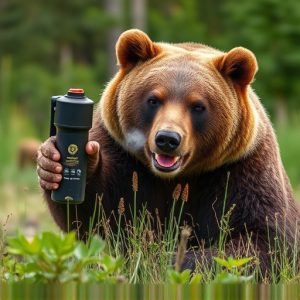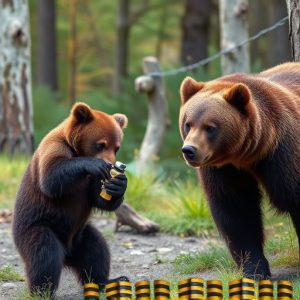Grizzly Bear Defense: Mastering Bear Spray and Wilderness Safety Techniques
Grizzly bear charging behaviors, driven by threats or surprises, require understanding for safe outd…….
Grizzly bear charging behaviors, driven by threats or surprises, require understanding for safe outdoor adventures. Key strategies include noise-making to avoid sudden encounters and using bear spray with a minimum 20% active ingredient for deterrence. Effectiveness depends on both active ingredient percentage and other components. A multi-layered approach combining bear spray, noise, "bear awareness," and local food storage regulations offers maximum grizzly bear protection in their habitat.
In the vast wilderness, encounters with grizzly bears can be life-altering. Understanding their behavior and charging patterns is key to survival. This article equips readers with essential knowledge to defend themselves against these formidable predators. We delve into the science behind bear spray as a primary defense mechanism, explaining the critical role of its active ingredient percentage. Additionally, we explore other effective wilderness safety strategies beyond bear spray, providing a comprehensive guide for adventurers and outdoor enthusiasts.
- Understanding Grizzly Bear Behavior and Their Charging Patterns
- The Role of Bear Spray: A Comprehensive Defense Mechanism
- Deciphering Bear Spray Active Ingredient Percentage: What Does It Mean?
- Effective Strategies for Wilderness Safety Beyond Bear Spray
Understanding Grizzly Bear Behavior and Their Charging Patterns
Grizzly bears, known for their immense strength and agility, are powerful predators that can charge at impressive speeds. Understanding their behavior is crucial when navigating wild landscapes. These bears primarily charge when they feel threatened or surprised, often using their keen senses to detect potential dangers. Their charging patterns vary; sometimes a charge is a mere warning, while other times it can be an aggressive display aimed at protecting their cubs or territory.
Knowledge of grizzly bear behavior can help hikers and campers avoid unnecessary confrontations. One effective strategy is to make noise while traveling through bear country to reduce the element of surprise. Additionally, carrying and knowing how to use bear spray is vital; it should contain a minimum 20% active ingredient for maximum effectiveness in deterring bears. Understanding these behaviors allows individuals to respect and co-exist with grizzlies, ensuring safe interactions during outdoor adventures.
The Role of Bear Spray: A Comprehensive Defense Mechanism
Bear spray, also known as bear repellent, is a crucial defense mechanism for individuals venturing into grizzly bear country. Its effectiveness lies in its active ingredient percentage—typically around 24%—which combines capsaicin, the same substance that gives chili peppers their heat, with other oils and chemicals. This potent mix creates an aerosol spray that, when sprayed directly at a bear, can deter an attack or even stop it mid-charge.
The high concentration of active ingredients ensures that the spray can be effective from distances ranging from 20 to 30 feet (6 to 9 meters), providing valuable time for individuals to escape or play dead if needed. Proper usage involves aiming at the bear’s face and eyes, as these are sensitive areas. Regular testing and refresher courses are recommended to ensure users understand how to deploy bear spray effectively in case of an encounter.
Deciphering Bear Spray Active Ingredient Percentage: What Does It Mean?
When considering bear spray as a defense against charging grizzlies, one crucial aspect is understanding its active ingredient percentage. This isn’t just about the amount of spray you can expect from each canister; it’s about the power and effectiveness of the chemicals inside. Active ingredients in bear spray are typically irritants like capsaicin (from chili peppers) or various types of pepper oil. The percentage refers to how concentrated these irritants are, usually measured in a percent solution.
A higher percentage doesn’t always mean better; it depends on the specific active ingredient and how your body reacts to it. For example, some people might find 15% capsaicin bear spray more effective or tolerable than a 30% formula. Reading product labels carefully is essential. Look for details about not just the active ingredient percentage but also any other components that could affect its performance. Understanding these nuances can make all the difference in effectively deterring a charging grizzly bear.
Effective Strategies for Wilderness Safety Beyond Bear Spray
When it comes to wilderness safety against charging grizzly bears, going beyond bear spray is crucial. While bear spray remains a vital tool, with an active ingredient percentage typically around 20% to 35%, effective strategies require a multi-layered approach for maximum protection. One key strategy is to make noise while navigating through potential bear habitats, as it can deter bears from approaching unexpectedly. Carrying and using loud whistles or singing at appropriate intervals can significantly reduce the risk of an encounter.
Another effective method is to practice what experts call “bear awareness” – being mindful of your surroundings, avoiding known bear territories if possible, and storing food securely in bear-resistant containers. Understanding local regulations regarding food storage and waste disposal is essential, as these practices play a significant role in preventing bears from becoming accustomed to human food sources, which can lead to aggressive behavior.
When venturing into wilderness areas known for grizzly bear populations, equipping yourself with knowledge and the right tools is paramount. Understanding bear behavior and investing in high-quality bear spray, especially considering its active ingredient percentage, can significantly enhance your safety. Beyond bear spray, adopting effective strategies like making noise to deter bears and knowing when to play dead can further reduce risks. Staying informed, practicing responsible wildlife encounters, and respecting the wilderness are key to a safe and enjoyable outdoor experience.


